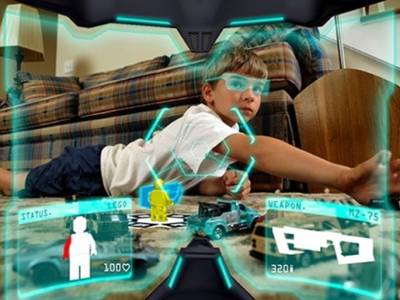The Magic of KidsTech
Enchantments and Curses
Who is most adapted to a world of social uncertainty, technological change, and constantly shifting habits and behaviors?


- Source: Scope, Augmented Reality Game
Above all others today, it may be kids. A journey into the unknown is almost a daily experience for kids. Their perception and knowledge of the world is in constant flux. Childhood is a continual negotiation with, and re-perception of, the bounds of reality. New knowledge, new skills, new experience, and perputual physical transformation is the norm, not the exception for kids.
With touchscreens, simple programming languages, and other lowered barriers for human-computer interaction, kids are poised to gain a high level of technical proficiency. When you combine this access with the resources kids have—time, a highly plastic brain, and the freedom to experiment with new behaviors, interests, and ways of being—it is not hard to imagine a level of empowerment for kids never before seen in human history. Futurists have proposed a coming “singularity,” when machine intelligence surpasses human intelligence, and a new power dynamic re-defines life as we know it. With kids’ technical capacity reaching new levels of sophistication, might we instead see a coming “kidularity,” when the power dynamic between adults and kids are completely re-defined?
The stakes have been raised for understanding kids and their relationship to new technologies. How are technologies shaping the minds and bodies of kids today? How will technologically advanced kids shape the future of society?
These were the questions at the heart of Technology Horizons research report “The Magic of Kids Tech.” In this report, we look at the enchantments, as well as the curses, of the remarkable technologies that are connecting, empowering, and enveloping kids today. Looking beyond just toys, or apps, the report takes a broad view of the new relationships emerging between kids, technology, and society through the lens of four fundamental domains: health, security, learning, and play. Core forecasts within each domain point to a child’s world in the next decade filled with empowering technologies, invisible protections, deep and constant networked connections, and shifting prohibitions. Also included in the report are original ‘artifacts from the future,’ developed at IFTF with a group of designers, educators, and other experts. These artifacts are conceptual tools that illustrate and dramatize some of issues and implications in health, learning, security, and play raised in our forecasts. They make tangible some of provocative tensions and unusual dynamics that will emerge in a technologically mediated and controlled environment.
We conclude with six “big stories”—broad social implications and emerging dilemmas that parents, kids, and society will have to navigate over the coming decade and beyond. These are:
1) Accelerated gratification: with instant consumption, ambient assistance, and contextual awareness, the delay between desire and result is shrinking. Instant feedback and constant affirmation of status will be the norm. Patience may be a virtue, but it will be measured in seconds, not days.
2) Total Kid Awareness: mobile devices, ubiquitous surveillance, facial recognition, and other tracking technologies means that knowledge of a child’s location and behavior will be constant and complete. Parents and guardians will have to choose when and where NOT to monitor their kids, as there will be few holes in the surveillance nets.
3) Juvenoia: the ‘exaggerated fear about the influence of social change on children,” as David Finklehor defines it, and the other fears we have of and for children growing up today is driving a series of social policies and laws to exert greater protection from and control over kids.
4) Programmable kids: will heavy scheduling and the algorythmic life infect a kids world as well? Will constant technological mediation make kids (and future adults) too dependent upon programs and interfaces between them and the world? If we are living through programmed routines and choice architectures, who are the programmers, and what are they programming us to be?
5) The Global Child: Reality for children today is not confined to their room, or house, or school—it is a global community of networked peers and endless virtual horizons. Creating and sharing videos with billions is a normal activity for many kids today, giving them a vastly different perspective on distances, times, and relationship with others than previous generations held.
6) Enchanted Kids: kids are empowered and connected in ways not seen before. This “magic” that they wield with ease, and the expectations that are being inculcated now for technology, society, and even reality, will echo through time as these generations grow into key players in the economy and society.
New technologies are going to help many kids play the part of the magician. They will enchant us with their creations and sleight of hand. They will also amaze us with their ability to escape from the technological chains we’re tying them up with as well. We live in a world of fast and accelerating change. Kids are in some ways ideally prepared to deal with change, and may have more to say and more power to influence the world than at any other time in history. That new empowerment will be the real magic kids bring to the world, and it may be the magic that saves the world from us adults. We are very pleased to publically release this important forecast report, and we welcome your comments and critiques.
Publication Date
November 2011
More Information
For more information on the future of kids' technology research, contact Sean Ness (sness@iftf.org) or Jake Dunagan (jdunagan@iftf.org).



